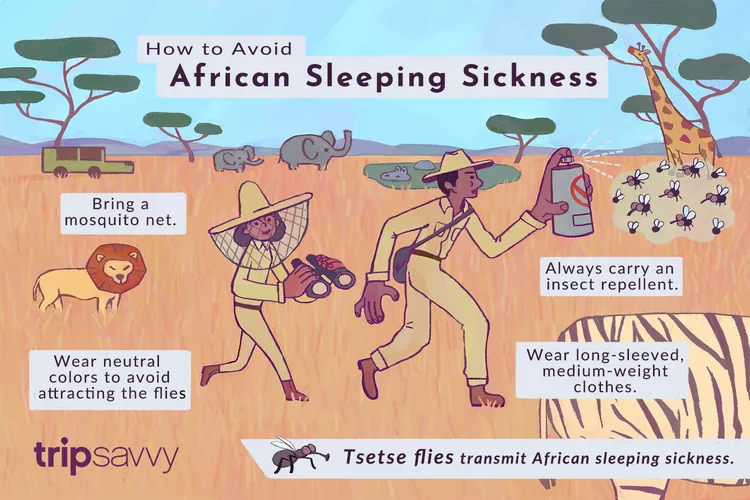Summary
The Tsetse Fly
The word “tsetse” means “fly” in Tswana, and it refers to all 23 species of the fly genus Glossina. Tsetse flies feed on the blood of vertebrate animals, including humans, thereby transmitting the sleeping sickness parasite from infected to uninfected hosts. These flies bear a resemblance to normal house flies; however, they can be identified by their distinct features. All tsetse fly species have a long proboscis extending horizontally from the base of their heads. When at rest, their wings fold over their abdomens, one exactly atop the other.
Sleeping Sickness in Humans
Among the 23 tsetse fly species, only six are known to transmit sleeping sickness to humans. There are two strains of human African trypanosomiasis: Trypanosoma brucei gambiense and Trypanosoma brucei rhodesiense. The former is predominantly prevalent, accounting for 97% of known cases and is typically found in Central and West Africa; it can go undetected for months prior to the emergence of serious symptoms. Conversely, the latter strain occurs less frequently, develops more rapidly, and is exclusively found in Southern and East Africa. Notably, Uganda is the only nation that exhibits both T.b. gambiense and T.b. rhodesiense.
Typical symptoms of sleeping sickness comprise fatigue, headaches, muscle aches, and high fever. Over time, the disease can affect the central nervous system, leading to sleep disorders, psychiatric disorders, seizures, coma, and ultimately, death. Fortunately, the incidence of sleeping sickness in humans is declining. According to the World Health Organization, reported cases fell below 10,000 for the first time in 50 years in 2009. By 2015, only 2,804 new cases were documented. This decline is attributed to enhanced control measures against tsetse fly populations, as well as improved diagnostic and treatment methods.
Avoiding Sleeping Sickness
Unfortunately, there are no vaccines or prophylactics available for human sleeping sickness. Consequently, the best way to avert infection is to steer clear of bites. However, if bitten, the likelihood of infection remains low (less than 0.1%). If planning to journey to a tsetse-infected region, ensure you pack long-sleeved shirts and long pants. Opt for medium-weight fabrics, as tsetse flies can penetrate thin materials. Neutral tones are essential because these flies are drawn to bright, dark, and metallic colors, particularly blue; this explains why safari guides often don khaki attire.
Additionally, tsetse flies are attracted to moving vehicles, so it is prudent to inspect your car or truck before embarking on a game drive. The flies typically take shelter in dense bushes during the hottest parts of the day, thus it is advisable to schedule walking safaris during early morning or late afternoon hours. Although insect repellent is only moderately effective against these flies, investing in permethrin-treated clothing and repellents containing active ingredients like DEET, Picaridin, or OLE is recommended. Ensure that your accommodation provides a mosquito net or consider carrying a portable one.
Treating Sleeping Sickness
Always remain vigilant for the symptoms mentioned above, even if they appear several months after returning from a tsetse-infected area. If you suspect potential infection, seek medical attention without delay and inform your healthcare provider of your recent travels to a tsetse country. The treatment you receive will depend on the strain of tsetse involved; however, in all cases, screening may be required for up to two years to confirm treatment success.
Likelihood of Contracting Sleeping Sickness
Despite the severity of sleeping sickness, you should not allow the fear of contracting it to deter you from visiting Africa. In reality, tourists are far less likely to become infected, as those most at risk are local farmers, hunters, and fishermen who have long-term exposure to tsetse areas. If concern persists, it may be wise to avoid travel to the Democratic Republic of the Congo (DRC), where approximately 70% of reported cases originate and where more than 1,000 new cases arise annually.
Popular destinations such as Malawi, Uganda, Tanzania, and Zimbabwe generally report fewer than 100 new cases each year. Regions like Botswana, Kenya, Mozambique, Namibia, and Rwanda have not experienced any new cases in over a decade, while South Africa is classified as sleeping sickness-free. In fact, South Africa is a suitable option for individuals concerned about insect-borne diseases due to its wealth of game reserves that are also malaria-free.
Sleeping Sickness in Animals
Animal trypanosomiasis poses a significant threat to livestock, particularly cattle. Infected animals exhibit symptoms of increasing weakness, rendering them unable to plow or produce milk. Pregnant cows may abort their offspring, and eventually, the affected animal succumbs. While prophylactic treatments for cattle exist, they can be costly and not always effective. Consequently, large-scale farming remains unfeasible in areas infested with tsetse flies. Those who attempt to raise cattle in such regions frequently face high rates of illness and mortality, with approximately 3 million cattle losing their lives annually due to the disease.
This situation positions the tsetse fly as one of the most influential species on the African continent. It inhabits an area encompassing about 10 million square kilometers of sub-Saharan Africa, representing fertile land that remains uncultivated. Therefore, the presence of the tsetse fly is often blamed for widespread poverty in Africa. Out of the 36 countries impacted by animal African trypanosomiasis, 30 are classified as low-income, food-deficit nations.
Interestingly, the tsetse fly also plays a critical role in maintaining extensive areas of wild habitat that would otherwise succumb to agricultural expansion. These regions serve as the last refuge for Africa’s native wildlife. Although safari animals, particularly antelope and warthogs, are vulnerable to this disease, they are comparatively less susceptible than cattle.




